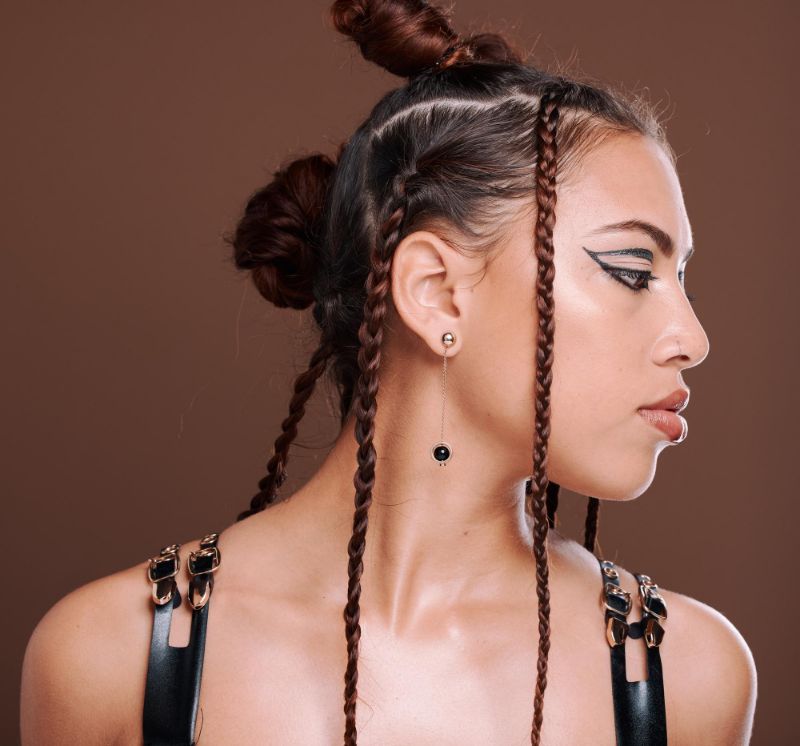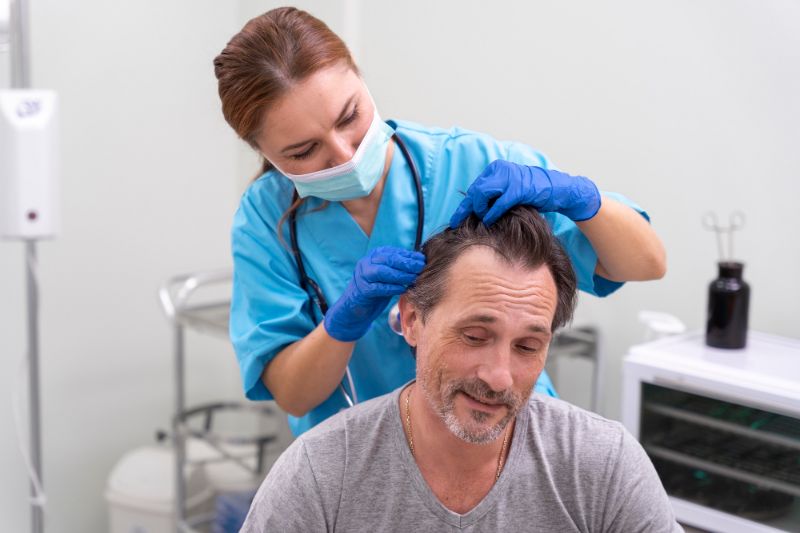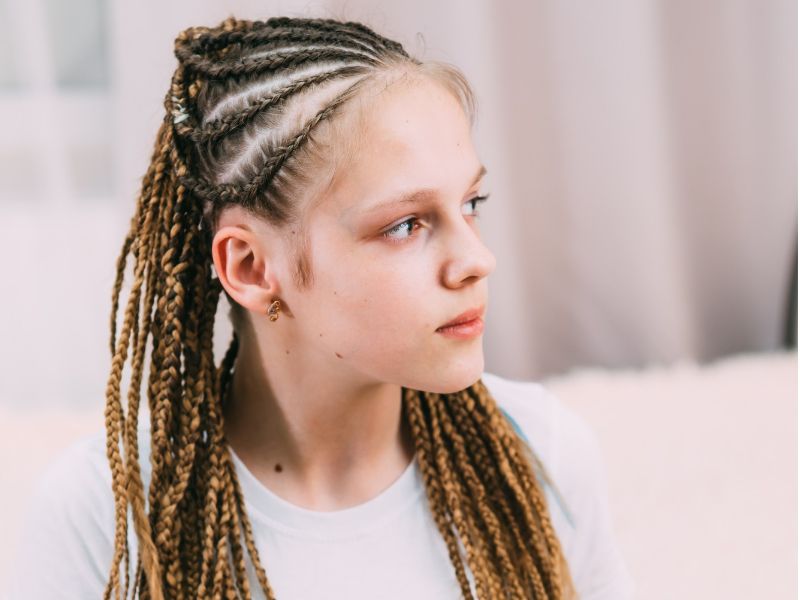Traction alopecia is a common hair loss condition that affects individuals who frequently wear tight hairstyles. This condition results from prolonged tension on the hair follicles, leading to hair breakage, hair loss, and thinning. Fortunately, traction alopecia is preventable and reversible with appropriate treatment measures. In this article, we will delve into the causes, symptoms, prevention, treatment, and recovery of traction alopecia.
What is Traction Alopecia?
Traction alopecia is a hair loss condition that occurs as a result of excessive pulling or tension on the hair. This condition is prevalent among people who regularly wear tight hairstyles, such as braids, weaves, cornrows, and ponytails. The constant tension on the hair follicles causes inflammation and scarring, leading to hair breakage and hair loss. Traction alopecia usually affects the hairline and temporal regions of the scalp.
what causes Traction Alopecia?
Traction alopecia is caused by repeated tension or pulling on the hair follicles. The following factors can contribute to the development of traction alopecia:
- Tight hairstyles: Tight hairstyles such as braids, weaves, cornrows, and ponytails can cause tension in the hair follicles, leading to hair breakage and hair loss.
- Chemical treatments: Chemical treatments like relaxers and perms have the potential to weaken hair and increase its vulnerability to damage from tight hairstyles and other forms of tension.
- Hair extensions: Hair extensions, particularly those that are attached using glue or braids, can cause tension in the hair follicles and lead to hair breakage and hair loss.
- Headwear: Wearing tight headwear such as hats, headbands, and helmets can cause tension on the hairline and temporal regions of the scalp, leading to hair breakage and hair loss.
- Hair accessories: Using hair accessories such as clips, barrettes, and elastics that are too tight or that pull on the hair can cause tension in the hair follicles, leading to hair breakage and hair loss.

Symptoms of Traction Alopecia
Traction alopecia can manifest in different ways, depending on the severity and duration of the hair pulling. Here you can find some common signs to be aware of:
- Hair loss: The most obvious symptom of traction alopecia is hair loss, which may appear as thinning hair, receding hairline, bald patches, or overall hair loss in the affected areas. The hair loss pattern usually follows the distribution of the tension on the hair follicles.
- Scalp irritation: Traction alopecia can cause scalp irritation, redness, inflammation, and tenderness, especially in the areas where the hair is pulled tight or attached to hair extensions.
- Itchy or sore scalp: In addition to irritation, traction alopecia can make the scalp feel itchy or sore due to the constant tension and pressure on the hair follicles.
- Tangled or matted hair: Traction alopecia can cause the hair to become tangled or matted, especially if it is not regularly detangled or if the hair extensions are left in for too long.
- Changes in hair texture: Prolonged tension on the hair follicles can alter the texture and quality of the hair, making it more brittle, dry, and prone to breakage.
If you notice any of these symptoms, it is important to consult a dermatologist or a hair specialist to determine the cause and the appropriate treatment for your condition. Early detection and intervention can help prevent further hair loss and promote hair regrowth.
Treatment Options for Traction Alopecia
The treatment for traction alopecia depends on the severity and duration of the hair loss and the underlying causes. Here are some common treatment options:
- Stop the source of tension: The first step in treating traction alopecia is to identify and eliminate the source of tension on the hair follicles, such as tight hairstyles, hair extensions, or headwear. Once the tension is removed, the hair follicles can recover and regrow.
- Topical treatments: Topical treatments such as minoxidil and corticosteroids may be prescribed to stimulate hair regrowth and reduce inflammation and itching in the affected areas. These treatments are usually applied directly to the scalp and may take several months to show results.
- Oral medications: In some cases, oral medications such as finasteride or spironolactone may be prescribed to block the effects of male hormones on the hair follicles and promote hair growth.
- Hair transplant: In severe cases of traction alopecia, hair transplant surgery may be an option to restore the hairline and cover bald patches. This involves removing hair follicles from the donor area (usually the back of the head) and implanting them into the recipient area.
- Platelet-rich plasma (PRP) therapy: PRP therapy involves injecting platelet-rich plasma (PRP) from the patient’s own blood into the scalp to stimulate hair growth and improve the overall health of the hair follicles.
- Scalp micro pigmentation: Scalp micro pigmentation is a non-surgical procedure that involves tattooing the scalp to mimic the appearance of hair follicles and create the illusion of a fuller head of hair.
- Hair Care regimen: In addition to medical treatments, it is important to follow a healthy hair care regimen that includes gentle shampooing, conditioning, and regular detangling to promote hair growth and prevent further damage to the hair follicles.

Natural Remedies for Traction Alopecia
The following natural remedies can help prevent and treat traction alopecia:
- Essential oils: Essential oils such as lavender, rosemary, peppermint, and tea tree oil have anti-inflammatory and antimicrobial properties that can soothe the scalp, reduce inflammation, and promote hair growth.
- Aloe vera: Aloe vera has a soothing effect on the scalp, reduces inflammation, and stimulates hair growth.
- Castor oil: Castor oil contains ricinoleic acid, which has anti-inflammatory and antimicrobial properties that can reduce inflammation and promote hair growth.
- Onion juice: Onion juice has sulfur compounds that can stimulate hair growth and improve hair density.
- Green tea: Green tea has antioxidants that can reduce inflammation and stimulate hair growth.
How to Prevent Traction Alopecia?
Traction alopecia can be prevented by taking simple measures to reduce tension on the hair follicles and promote hair health. Here are some tips to prevent traction alopecia:
- Avoid tight hairstyles: Tight hairstyles such as braids, weaves, ponytails, and buns can put excessive tension on the hair follicles and cause traction alopecia. Avoid wearing these hairstyles for extended periods and opt for loose styles that do not pull on the hair.
- Use proper hair accessories: Use hair accessories such as hair ties, clips, and bands that are gentle on the hair and do not pull or tug. Avoid using rubber bands or metal clips that can damage the hair follicles.
- Limit the use of heat and chemicals: Frequent use of heat styling tools and chemical treatments such as relaxers, perms, and dyes can weaken the hair and make it more susceptible to breakage and damage. Limit the use of these treatments and use heat-protectant products when styling with heat.
- Practice good hair care habits: Follow a healthy haircare regimen that includes gentle shampooing, conditioning, and regular detangling to promote hair growth and prevent hair breakage and damage. Use a wide-tooth comb or a detangling brush to gently remove tangles from wet hair.
- Take breaks between hairstyles: Allow your hair to rest and recover between tight hairstyles and hair extensions. Avoid wearing these styles back-to-back and give your hair time to recover.

By following these simple tips, you can prevent traction alopecia and promote healthy hair growth. If you have already experienced hair loss due to traction alopecia, it is important to consult a dermatologist or hair specialist to determine the best treatment options for your condition.
Hairstyles to Avoid Traction Alopecia
The following hairstyles should be avoided to prevent traction alopecia:
- Tight braids: Braids that are too tight can cause tension in the hair follicles, leading to hair breakage and hair loss.
- Cornrows: Cornrows can cause tension in the hair follicles, leading to hair breakage and hair loss.
- Weaves: Weaves can cause tension in the hair follicles, leading to hair breakage and hair loss.
- Ponytails: High ponytails can cause tension on the hairline and temporal regions of the scalp, leading to hair breakage and hair loss.

Avoid Cornrows to prevent Traction Alopecia
Traction Alopecia Recovery
Recovery from traction alopecia can be a slow process and varies depending on the severity of the condition. In mild cases, the hair may begin to regrow within several months, while more severe cases may take up to a year or more for noticeable improvement. During the recovery period, it is important to adopt healthy hair care practices and avoid any further damage to the hair follicles. This includes avoiding tight hairstyles that pull on the hair, limiting the use of heat styling tools and chemical treatments, and following a balanced diet that is rich in nutrients that promote hair health.

In addition to adopting healthy hair care practices, appropriate treatment measures can help accelerate the recovery process. These may include topical treatments such as minoxidil or corticosteroid creams, as well as hair transplant surgery in severe cases.
Traction Alopecia Before and After
Taking before and after pictures is an essential part of monitoring the progress of traction alopecia. In the before pictures, you may notice hair breakage, hair loss, and thinning, which can be distressing and may affect your self-confidence. However, taking after pictures can be a great way to track your progress and celebrate your achievements.
In the after pictures, you will observe hair regrowth and improved hair density, which can be a source of encouragement and motivation to continue with your hair care routine. Additionally, comparing your before and after pictures can help you identify what is working for your hair and what needs to be improved. Overall, before and after pictures can be a powerful tool in the recovery process for traction alopecia.
Conclusion
In conclusion, traction alopecia is a preventable and reversible hair loss condition that can result from prolonged tension on the hair follicles caused by tight hairstyles, chemical treatments, hair extensions, headwear, and hair accessories. Early detection and intervention are crucial in preventing further hair loss and promoting regrowth. Treatment options range from stopping the source of tension to medical and surgical interventions, such as PRP therapy and hair transplant surgery. It is also essential to follow a healthy haircare regimen and consider natural remedies.
With services such as Remotederm, individuals can access online dermatology consultation services, eliminating the need for long waits to visit dermatologists in person.
FAQs
- Can traction alopecia be prevented?
Yes, traction alopecia can be prevented by avoiding tight hairstyles, using hair accessories that are not too tight, and taking breaks from wearing hair extensions.
- How is traction alopecia diagnosed?
Traction alopecia is diagnosed by a dermatologist or a hair specialist who will examine the scalp and hair follicles and ask about the patient’s hair care practices and medical history.
- How long does it take for hair to regrow after experiencing traction alopecia?
The time it takes for hair to regrow after traction alopecia depends on the severity of the condition and the treatment used. It may take several months to a year or more for the hair to regrow fully.
- Can traction alopecia cause permanent hair loss?
In severe cases where there is extensive scarring and damage to the hair follicles, traction alopecia can cause permanent hair loss.
- Is traction alopecia more common in certain ethnic groups?
Traction alopecia is more common in African American women and other ethnic groups with tightly coiled or textured hair that is more prone to damage from tight hairstyles.
- Can wearing wigs or hairpieces cause traction alopecia?
Yes, wearing wigs or hairpieces that are too tight or attached using glue or clips can cause traction alopecia if they pull on the hair and scalp.
- Is traction alopecia reversible?
Yes, traction alopecia is reversible with appropriate treatment measures such as stopping the source of tension, using topical or oral medications, or undergoing hair transplant surgery.
